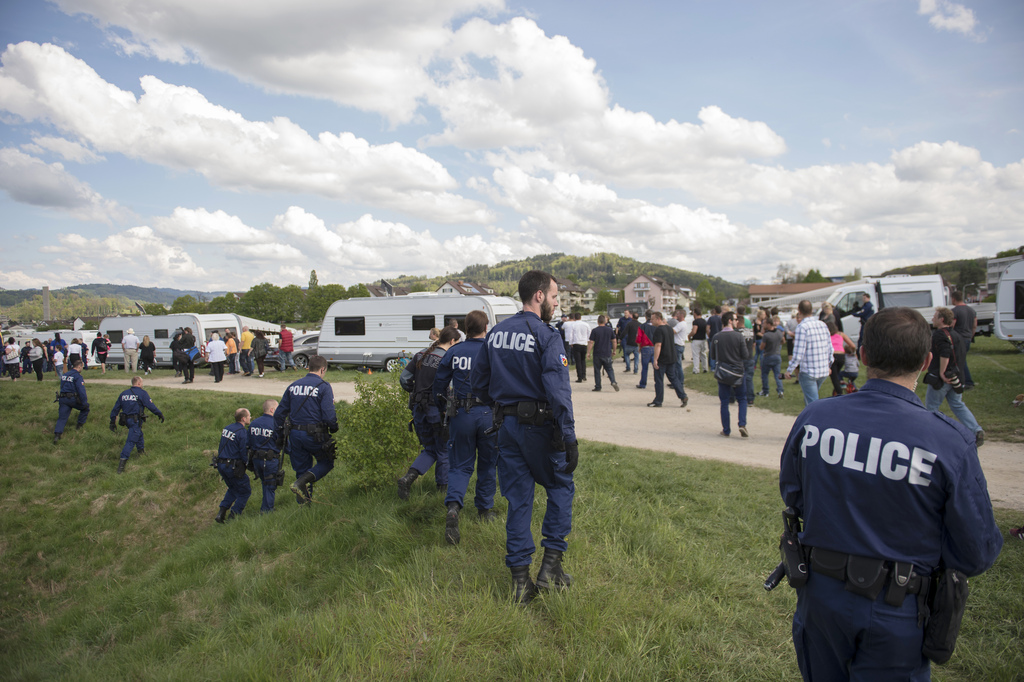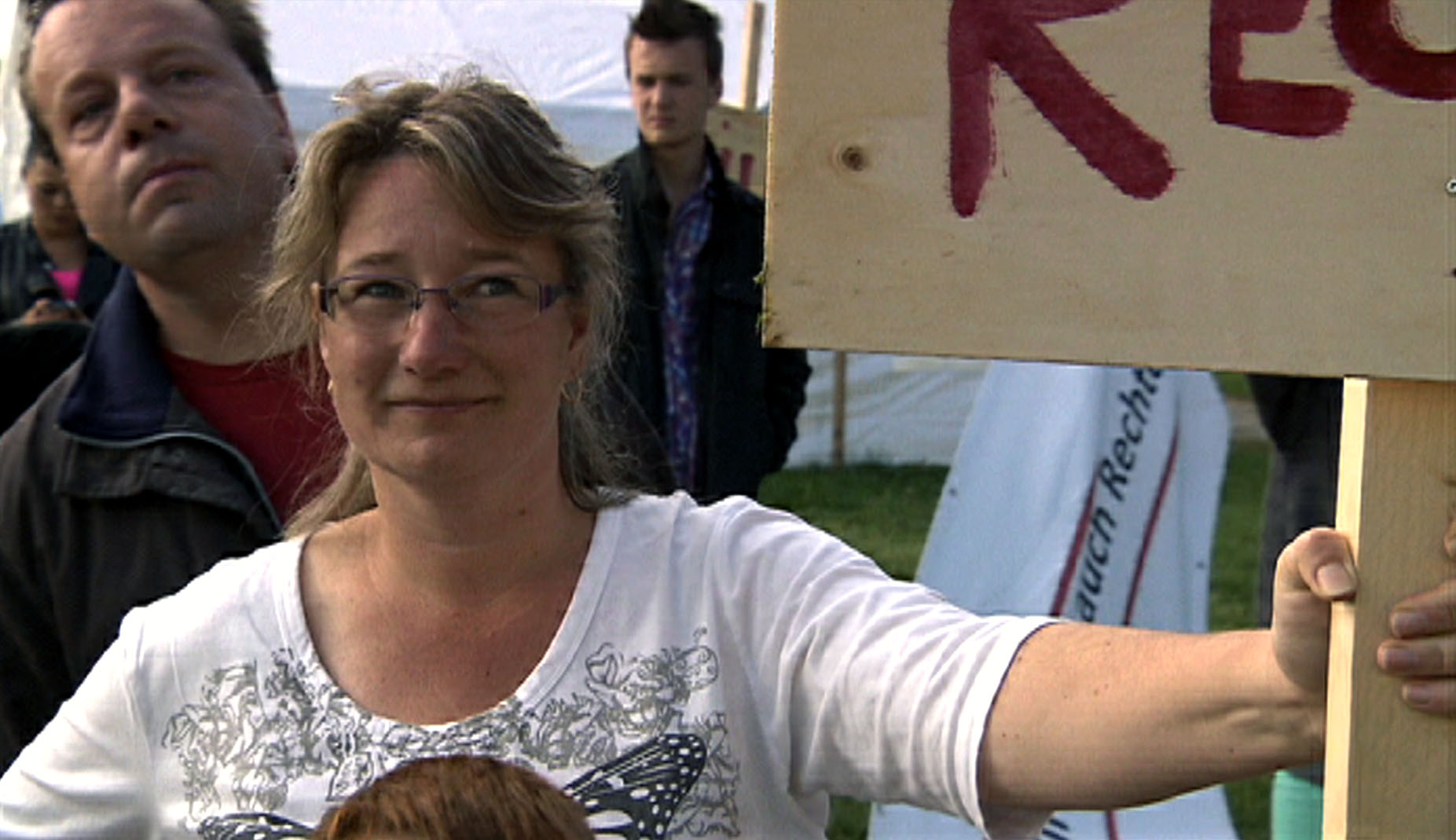
The trouble with travellers

A group of nomadic Jenish people hit the headlines in late April when they arrived in the capital Bern, and set up camp to protest the lack of places made available to them. Switzerland’s “most attractive town”, for example, has “no interest” in respecting their rights.
Ernst Lehmann has nothing bad to say about his new, temporary neighbours beyond the fact that they hooked up a hose to a tap in his garden without asking. The spry retiree continually stops his gardening to look over the fence at the field occupied by the Jenish group’s dozens of vehicles.
With the exception of running water, the new arrivals have brought everything they need with them, including toilets in their modern trailers. The licence plates indicate that they have come from across Switzerland.
“Take a look: we’re as tidy as the permanent residents. We’re proper Swiss who pay taxes, do our military service and pay rent for the places we camp,” said Mike Gerzner.
The 30-year-old is president of the Movement of Swiss Travellers, a splinter group of the Jenish – a nomadic people that have enjoyed official minority status in Switzerland since 1998.
The cities of Bern and Biel say they plan to each make available sites where 50 caravans or mobile homes can stay until August. The two canton Bern cities hope this temporary initiative will give them time to find a medium to long-term solution for the Jenish community.
The president of the Bern government announced on 6 May that the canton planned to create three to five locations for the Jenish people to stay as well as two transit camps for foreign travellers.
Life of a peddler
Between 3,000 and 5,000 of the Jenish are travellers, who move from place to place in Switzerland each summer, peddling goods, dealing in scrap metal, or doing odd jobs such as knife grinding, house painting or working as tinsmiths.
But for decades there haven’t been enough places for them to set up camp for a few days in order to find customers. “We sometimes attempt to stay in a field but that has become more difficult since the authorities have put farmers under pressure.”
The life of a peddler is also more trying. “There are communes which distribute flyers calling on residents not to give any work to travellers,” added the young man.
In 2003 the Switzerland’s Supreme Court recognised the right of travellers to suitable locations for their camps and ruled that these should be taken into account as part of land-use planning.
But little has happened since then. Instead of the required 80 transit areas there are 45 at the most. The situation is no better for locations where they are allowed to stay for the winter. There are only 15 instead of the 40 needed.

More
Travellers fight for turf
Poor image
“Fed up with empty promises” hundreds of men, women and children from the Movement of Swiss Travellers went to the Swiss capital to protest. The group expressly separates itself from foreign “gypsies” claiming these people are responsible for the poor image given to travellers.
The protestors were stopped by police before they reached the centre of the city and escorted to a field on the outskirts. But because the spot was going to be used as a car park for an annual fair, the police then issued an ultimatum for them to leave. Dozens of police surrounded the camp and brought several tow trucks into position.
The umbrella organisation representing Swiss travellers groups did not take part in the demonstration, but neither did it distance itself from it. “The protest didn’t take place in accord with us,” the organisation’s president, Daniel Huber said. “We’ve been trying to find a solution via political means.”
Up until now with little success, Huber admits, expressing understanding for the protestors. “There are clearly not enough places.”
Apart from Aargau, Graubünden and partly St Gallen and Zurich, the cantons have not achieved anything concrete. “Now it’s got to the point where travellers are calling out for their rights,” said Huber. “We have to heavily invest.”
Daniel Huber
We’ve been trying to find a solution via political means. There are clearly not enough places.
Dealing with the matter
Canton Schwyz is seen as a special case in Switzerland. Numerous Jenish people have their roots there.
Peter Reichmuth, secretary of the Department of Economic Affairs of canton Schwyz and contact person for questions concerning travellers, is aware that the cantons should have dealt with the matter years ago.
Still, he does not want to confirm that nothing has been done. He cites comprehensive investigations conducted over previous years.
After the people rejected a transit area in the canton’s capital, Schwyz, the governing council at the end of 2012 adopted a concept setting out how the tasks would be split between the canton and the municipality as well as the financing of the sites.
“We are right now in intense discussions again with the goal of creating two sites in the canton.” There is already an interim result.
“We are very grateful that Hoch-Ybrig cable car operators have agreed to make their valley-level car park available to the travellers during the summer months, as long as no other events are planned,” Reichmuth said.
Up until now there was no single location for travellers’ camps in the canton of Schwyz and only one transit area in the municipality of Feusisberg.
Switzerland has tried to make the Jenish population settle down. Between 1926 and 1973 an aid organisation of the foundation Pro Juventute and the guardianship authorities took away more than 600 children from their parents.
The federal government, welfare centres, teachers, pastors and aid organisations supported the operation Relief Organisation for Children of the Roads.
Many Jenish children were placed with rural families, supposedly as children in care. They were exploited as cheap labour and often mistreated. Because of public pressure, the operation was stopped in 1973.
In 1987 the cabinet apologised. A foundation was set up to guarantee the future of the travellers, their living conditions and their way of life in Switzerland.
No infrastructure
“This location, however, cannot be used,” said the local councillor Beat Flühler. “At the moment it is covered with logs because there is woodcutting going on in the forest behind the site.”
Travellers have not been seen for years. There is no running water, no electricity or sanitary facilities. We would have to make “huge” investments in order to repair and maintain the transit area, Flühler explained.
Feusisberg has only recently made its mark as the magazine Die Weltwoche has named it the “most attractive place in Switzerland” in a rating of municipalities. The community south of Lake Zurich, where almost one of five inhabitants is a millionaire, owes this top ranking to its labour market, its demographic development, housing activity, social structure, its wealth and above all its low tax burden.
The community is financially well-off, Flühler confirmed, “but to be honest, it is not interested in a transit area”.
Gypsy: The term has been considered discriminatory since World War II, as the Nazis killed hundreds of thousands of Roma people. Today, many of the Jenish, Sinti and Roma proudly call themselves gypsies.
Roma is the generic term for all members of the various people, which speak Romany or belong to the Romani people, which originally came from India and Persia. It is estimated that there are between eight and ten million Roma.
Sinti are the descendants of those Romani people, who emigrated to central Europe in the 15th century. They primarily live in France, Italy and Germany. In France they are called Manuches.
The Jenish population primarily live in Germany, Switzerland, Austria and France. The roughly 100,000 people speak their own language. Jenisch is an idiom derived from Yiddish, which varies depending on region and family.
In Switzerland, about 90% of travellers are Jenische. Among the 30,000 most of them have settled down. Between 3,000 and 5,000 are still always or partly travelling. They live in family clans with up to 20 people in six to eight caravans.
Since 1998, they have been protected by the Council of Europe’s Framework Convention for the Protection of National Minorities. The Swiss Jenish are Swiss citizens. They are registered at the municipalities where they stay over winter and where their children go to school. While travelling during the summer, parents and private tutors oversee the childrens’ education.
(Source: Federal Office for Culture)
(Translated from German by Dale Bechtel and Chantal Britt)

In compliance with the JTI standards
More: SWI swissinfo.ch certified by the Journalism Trust Initiative






























You can find an overview of ongoing debates with our journalists here . Please join us!
If you want to start a conversation about a topic raised in this article or want to report factual errors, email us at english@swissinfo.ch.